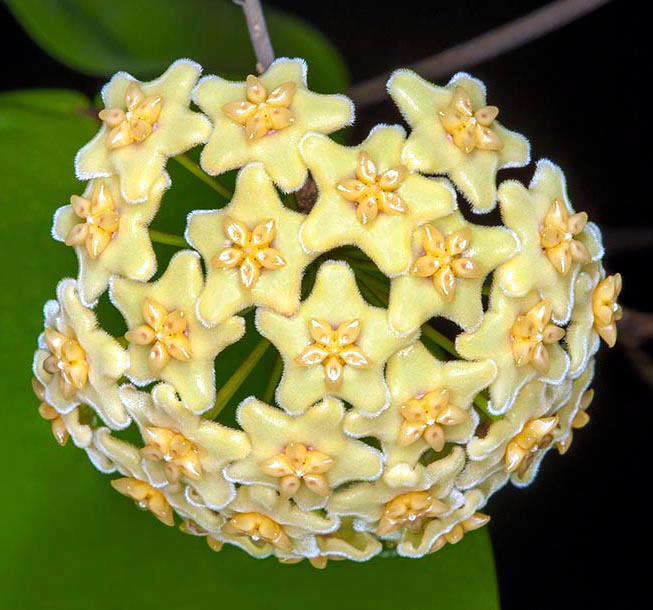Family : Apocynaceae

Text © Pietro Puccio

English translation by Mario Beltramini
The species is native to Papua New Guinea where it lives in the humid forests up to about 1000 m of altitude.
The genus is dedicated to Thomas Hoy (ca. 1750-1800) botanist and curator of the gardens of the duke of Northumberland; the name of the species is the Latin adjective “dischorensis” = of Dischore, place of the Province of Morobe, with reference to the origin site of the type species.
The Hoya dischorensis Schltr. (1913) is a sarmentose epiphyte little ramified with thin stems, ascending, provided of sparse adventitious roots. The leaves, on a 0,6-1 cm long petiole, are oblong with acute apex and entire margin, rather fleshy, glabrous, of intense green colour, 6-12 cm long and 3-6 cm broad.

Native to Papua New Guinea, the Hoya dischorensis is a sarmentose epiphyte poorly ramified with thin stems. Umbelliform inflorescences, on short peduncle, bearing 10-25 more or less intense yellow cream flowers, with 5 ovate lobes corolla with acute apex and thickly villous margin of 1-1,5 cm of diameter © Giuseppe Mazza
It usually reproduces by cutting, with 2-3 nodes, in very sandy loam or agriperlite maintained humid at a temperature of 26-28 °C, and by air-layering; the first blooming may take place in the same year.
Particularly floriferous species that needs a warm-humid climate, therefore suitable to be cultivated in open air exclusively in the tropical and humid subtropical climate regions. It requires high luminosity, but not direct sun, and a very porous and draining substratum, rich of organic substance, neutral or slightly acidic.
Elsewhere, it is to be cultivated in pot, guided on appropriate supports, with the same aforementioned precautions and lowest winter temperatures over the 16 °C. The waterings must be regular and abundant in summer, allowing the substratum to partially dry up before watering again, more spaced in winter, but without ever allowing it to dry up completely; useful are the nebulizations, with non calcareous water at ambient temperature, in presence of high temperatures and low atmospheric humidity. For the fertilizations, in spring-summer, can be utilized the same hydrosoluble products, with microelements, specific for the epiphytic orchids. The repottings are to be done when the substratum gives signs of deterioration, preferably in late spring-summer, having care to leave then the plant dry till when do not appear signs of vegetative regrowth.
→ To appreciate the biodiversity within the APOCYNACEAE family please click here.
